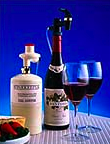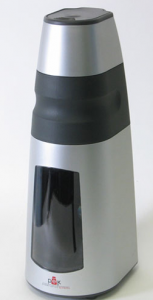Tightly sealed, a bottle of wine can keep for years. In fact, if you've been reading this blog you know that many times, the best thing you can do for your bottles is to let them hang out in your cellar for a few years. Wine slowly improves with age, in part because of a minimal exposure to a small amount of oxygen, which facilitates many of the reactions amongst the chemicals in the bottle.
But once opened, wine is extremely delicate. An opened bottle is exposed to a drastically different environment than it is used to; one full of air, light, and temperature fluctuations: all the factors that drastically change the rate of the reactions the wine is undergoing. An opened bottle of wine will oxidize and the next day will be, at best flat in flavor, and at worst, be full of acetic acid and taste like vinegar. The wine drinker will have to pour that long-anticipated wine down the drain.
And so the wine drinker faces a conundrum: she must wait an agonizingly long time for her wine to reach the perfect age, using part science, part artistry to decide when it will reach its peak in flavor, but once she opens the wine, she must drink it all within a few hours. Some bottles are so good that she'd rather savor them slowly. And sometimes she'd like to enjoy a single glass of good wine without imbibing in the whole bottle. Those who make an investment in wine shouldn't feel pressured to down the whole bottle in a single sitting.
Fortunately, new technologies now allow the wine connoisseur to have her wine and drink it too. Wine preservers (also called wine savers or wine keepers) allow an open bottle to stay perfectly fresh and ready to be enjoyed for several days. Wine preservers attach to the top of the bottle and work by removing some of the air in the space between the wine and the top. Some wine preservers displace the air in the bottle with a harmless gas, a practice that ensures that all of the air is removed and the aging process is drastically slowed.
attach to the top of the bottle and work by removing some of the air in the space between the wine and the top. Some wine preservers displace the air in the bottle with a harmless gas, a practice that ensures that all of the air is removed and the aging process is drastically slowed.
Vintage Cellars offers several different types of wine preservers. The Wine Keeper is a great one. Its design is simple: a stopper attached to a small canister of nitrogen gas which flows into the bottle, keeping oxygen out and flavor in.
 But the Pek Wine Steward is my personal favorite. It replaces the air in the bottle with argon gas instead of nitrogen, and also micromanages the temperature of the wine bottle, serving as a perfect small-scale wine refrigerator. Its sleek modern design is attractive enough to look great in any kitchen.
But the Pek Wine Steward is my personal favorite. It replaces the air in the bottle with argon gas instead of nitrogen, and also micromanages the temperature of the wine bottle, serving as a perfect small-scale wine refrigerator. Its sleek modern design is attractive enough to look great in any kitchen.
If you've ever had a bottle of wine go bad because you didn't want to drink the whole thing in one sitting, check out these great products from Vintage Cellars and savor your wine at your own pace.



